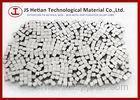

High wear resistance 3.0 mm Tungsten Alloy Cube forelectrical instrumentation
| Place of Origin: | Guangdong |
|---|
Company Profile
| Location: | Wuxi, Jiangsu, China (Mainland) |
|---|---|
| Business Type: | Manufacturer |
| Main Products: | Tungsten Carbide Rod, Tungsten Carbide Rod Blanks, Tungsten Carbide Bar |
Product Detail
| Model No.: | AIA-1 |
|---|
Product Description
3.0 mm Tungsten Alloy Cube High gravity alloy for Military industry
Description:
Tungsten heavy alloys which can also be called high gravity alloys are refractory metals, it is a kind of alloy using tungsten as matrix and components nickel, iron, copper and other alloying elements.
Basically the most common high density Tungsten alloys is divided into two series, W-Ni-Fe and W-Ni-Cu, sometimes even W-Ni-Cu-Fe.
Our processing route for tungsten heavy alloys is as follows:Firstly, mix the calculated amount of elemental powders according to certain ratio, ball milling to even all powders and refine powder grains. Then, employ cold pressing and liquid phase sintering to almost full density. The matrix alloy melts and some tungsten dissolves into solution during liquid phase processing, resulting in a microstructure through which large tungsten grains (20–60µm) are dispersed in the matrix alloy. The as-sintered material often is subjected to certain aging treatments, finally leading to improved strength and hardness in the heavy alloys.
Features of Tungsten heavy alloys
1. high density(15.8-18.5g/cm3)
2. environmentally friendly composition compared to lead
3. high hardness
4. high absorption capacity against X-rays and gamma rays
Due to high density, high melting point, excellent hardness, superior wearing resistance, high ultimate tensile strength, high ductility, well machinability, non-toxic and environmental friendly, high impact resistance and crack resistance, tungsten heavy alloys are widely used in counterweight and military defense applications.
Specifications:
1. AMS Specifications
AMS-T-21014 | Class 1 | Class 1 | Class 2 | Class 2 | Class 3 | Class 3 | Class 4 |
Composition | 90W7Ni3Fe | 91W6Ni3Fe | 92W5Ni3Fe | 93W4Ni3Fe | 95W3Ni2Fe | 96W3Ni1Fe | 97W2Ni1Fe |
Density (g/cm3) | 17.1±0.15 | 17.25±0.15 | 17.50±0.15 | 17.60±0.15 | 18.10±0.15 | 18.30±0.15 | 18.50±0.15 |
Heat Treatment | Sintering | Sintering | Sintering | Sintering | Sintering | Sintering | Sintering |
Tensile Strength (MPa) | 900-1000 | 900-1000 | 900-1100 | 900-1100 | 920-1100 | 920-1100 | 920-1100 |
Elongation (%) | 18-29 | 17-27 | 16-26 | 16-24 | 10-22 | 8-20 | 6-13 |
Hardness (HRC) | 24-28 | 25-29 | 25-29 | 26-30 | 27-32 | 28-34 | 28-36 |
2. Our General Sizes (Customization accepted)
Dimensions | 3.0x 3.0 x 3.0 mm |
Tolerance | ± 0.12mm |
Content | W: 94% min , Ni:4% , Fe:2% |
Weight | 0.50g (± 0.02g) |
Density | ≥ 17.95 g/cm3 |
Hardness | 25-36 |
Elongation | 10% |
Packaging:

Applications:
As tungsten heavy alloy shares high and adjustable density, high strength and high hardness together with excellent anti-corrosion, anti-abrasion, anti-fatigue machinability and weldability properties, it is widely used in counterweight and military defense applications.
For balance weight, such as golf counterweight, racing motorcycles, aerospace gyroscope, helicopters, vehicles, boats and yachts, sailboat, submarine and other vessels.
For military industry, such as penetrating projectiles, counterweights for military defense, projectiles in the missile weapons, armor piercing ammunition, prefabricated fragments.
Advantages of tungsten heavy alloy:
The most outstanding characteristic of heavy metal alloys is the high density, which is far higher than nickel, titanium and lead alloys. It

